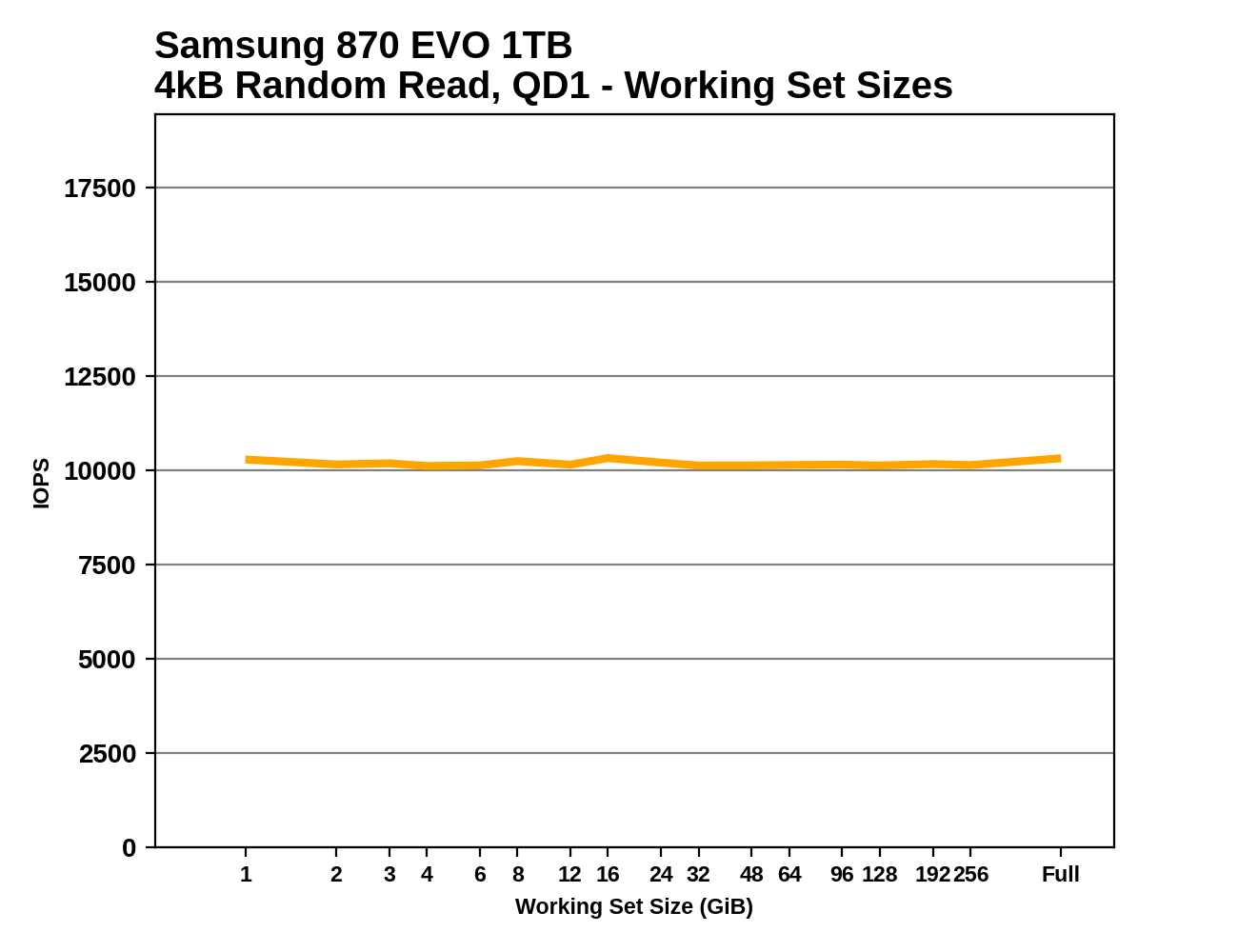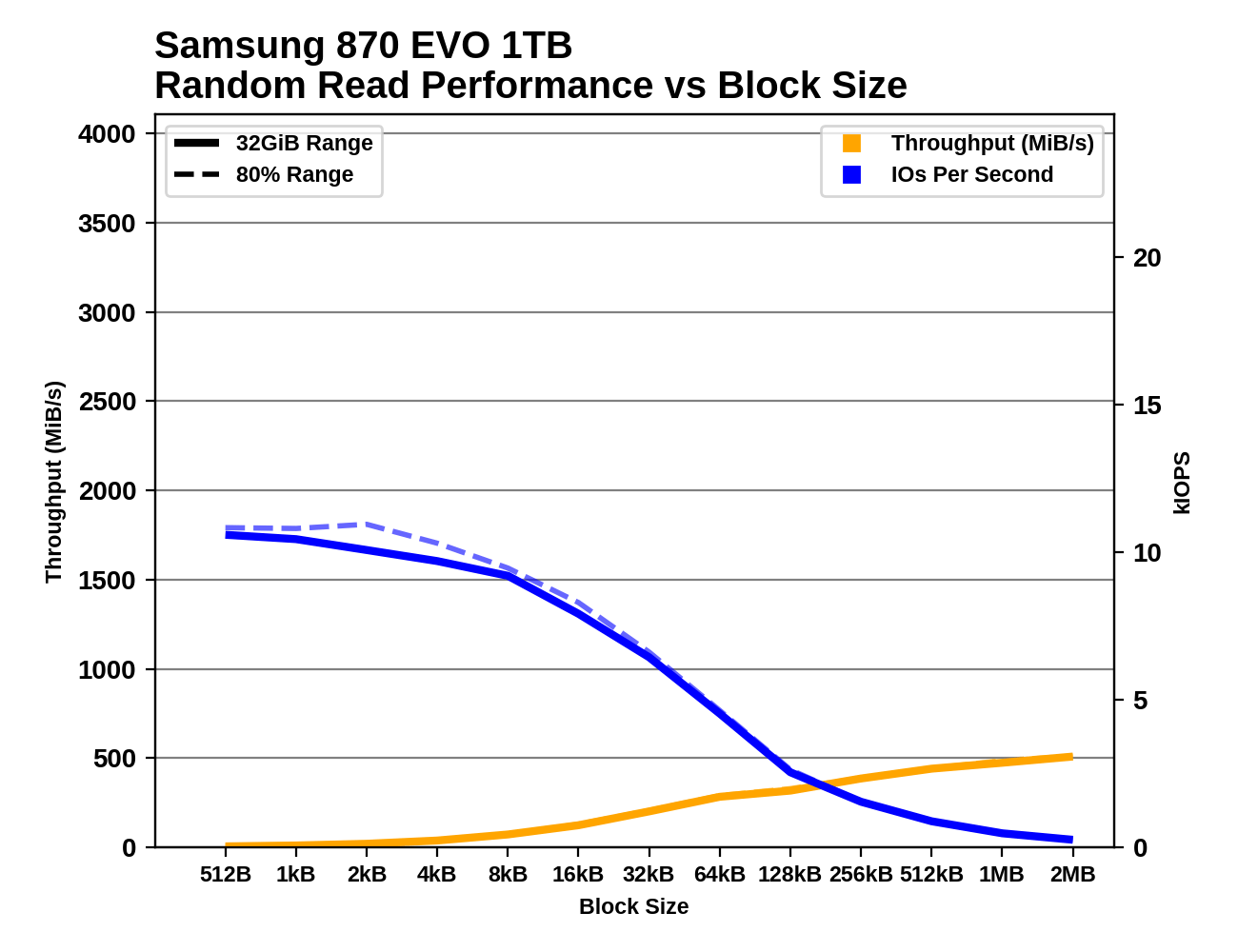The Samsung 870 EVO (1TB & 4TB) Review: Does the World Need Premium SATA SSDs?
by Billy Tallis on February 17, 2021 8:00 AM ESTAdvanced Synthetic Tests
Our benchmark suite includes a variety of tests that are less about replicating any real-world IO patterns, and more about exposing the inner workings of a drive with narrowly-focused tests. Many of these tests will show exaggerated differences between drives, and for the most part that should not be taken as a sign that one drive will be drastically faster for real-world usage. These tests are about satisfying curiosity, and are not good measures of overall drive performance. For more details, please see the overview of our 2021 Consumer SSD Benchmark Suite.
Whole-Drive Sequential Fill
 |
|||||||||
| Pass 1 | |||||||||
| Pass 2 | |||||||||
Some of our other tests have shown a few signs that the 870 EVO's write performance can drop when the SLC cache runs out, but this straightforward sequential write pass over the entire drive doesn't reveal any such behavior. The 870 EVO's sequential write performance is extremely consistent, even on the second write pass.
 |
|||||||||
| Average Throughput for last 16 GB | Overall Average Throughput | ||||||||
Due to the excellent performance consistency, the Samsung 870 EVOs edge out the other SATA drives with marginally higher average sequential write speeds. The entry-level NVMe drives end up much worse off than the mainstream SATA drives once their caches run out, but the more mainstream NVMe drive blows them all away.
Working Set Size
 |
|||||||||
As expected, the Samsung 870 EVO's random read performance shows basically no variation across a range of working set sizes, and that read performance is at least a little bit faster than any of the other SATA drives or the entry-level NVMe drives.
Performance vs Block Sizes
 |
|||||||||
| Random Read | |||||||||
| Random Write | |||||||||
| Sequential Read | |||||||||
| Sequential Write | |||||||||
There are no particular surprises in how the Samsung 870 EVO handles IOs of different block sizes. Unlike some drives, it has no trouble with sub-4kB IOs. It offers moderate improvements over the 860 EVO for mid-sized random reads (up to about 128kB). The one negative is that for writes we again see more inconsistency from the 870 EVO than the 860 EVO when testing an 80% full drive. The simple whole-drive sequential write test may not have been able to reveal any SLC caching troubles, but it does seem clear that the caching behavior has some performance regressions for more complicated workloads on a drive that's more well-used—though it's still unlikely to matter for any typical real-world consumer workload.










136 Comments
View All Comments
Glaurung - Wednesday, February 17, 2021 - link
The main barrier for the formal death of SATA are hundreds of millions of perfectly usable older systems that don't support NVME or have limited NVME slots.Qasar - Wednesday, February 17, 2021 - link
" Main barrier for the formal death of SATA is still cost as NVMe still carries a slight premium over SATA and consumer systems have limited PCIe connectivity. "i think you might be also forgetting the aspect of the space requirements of the nvme connector as well.
Lord of the Bored - Wednesday, February 17, 2021 - link
I've always thought SATA was a mistake.Removing the ability to chain multiple drives made for an ugly cabling situation, and the connectors are flimsy as hell. The new power connector in particular served no purpose whatsoever aside from annoyance.
If it had used more robust connectors and allowed chaining drives, it would've been fantastic. But that would've been to much like the right decision for them to entertain it.
Glaurung - Wednesday, February 17, 2021 - link
SATA on the desktop and in NAS boxes is still very much alive, TYVM.Sata SSDs will continue to be made and sold as long as there are older computers in use that have a SATA bay in them. My main computer only has 1 NVME slot, but it also has a SATA bay. WIthout that SATA bay I'd have to have all my files crammed onto on a single SSD.
Kamen Rider Blade - Wednesday, February 17, 2021 - link
The technology to update SATA is there, it just takes a bit of will power from the SATA group to borrow the SAS speeds and bring it to the consumers.The SATA connector is far better suited for "Hot Swap" and M.2 was never designed for "Hot Swap" capabilities.
powerarmour - Wednesday, February 17, 2021 - link
No, we'll require SATA for bulk storage for a good few years yet.How many M.2 only NAS systems are there?
CaedenV - Wednesday, February 17, 2021 - link
SATA is still perfectly fine for old spinning rust drives. Sure the burst performance could be better with a faster connection... but how often is that needed? For sustained data transfers SATA3 is still faster than any spinning drives on the market that cap out at 150-200MBps on a good day.watzupken - Wednesday, February 17, 2021 - link
I don't think SATA is going to go away anytime soon. While it is not as fast as a good NVME SSD, it makes up for it by offering a good price to capacity ratio. It just like why mechanical drive still exists today. Most NVME SSDs are affordable up to around 1TB, and at higher capacity, the prices goes up significantly. Also one is usually limited to 2 or 3 NVME slots due to limitation of number of PCI-E lanes. Thus, having the SATA ports to supplement additional storage is unlikely to go away, at least from a desktop perspective.sonny73n - Thursday, February 18, 2021 - link
"..,Most NVME SSDs are affordable up to around 1TB, and at higher capacity, the prices goes up significantly."Please stop spouting BS.
ADATA SX8200 Pro 2TB M.2 $239
Samsung 870 EVO 2TB SATA $249
Both is on Amazon right now.
Oxford Guy - Friday, February 19, 2021 - link
2TB on black Friday for an ADATA over a year ago. $250 isn't impressive.